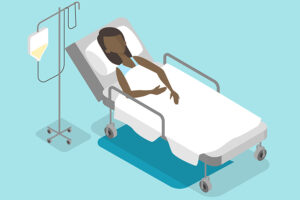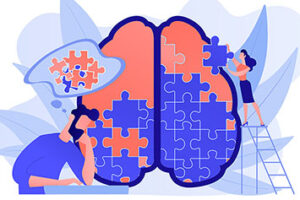Catatonic depression is a rare and serious mental illness. It is characterized by a person becoming mute and unmoving, sometimes for extended periods of time. This can be very frightening for friends and family members of the person suffering from depression. If you or someone you know is experiencing these symptoms, it is important to get help right away. In this blog post, we will discuss what catatonic depression is, its symptoms, and how to get help.
Contents
Defining Catatonic Depression

Catatonic depression is a rare yet serious mental illness that characterizes by a person becoming mute and unmoving, sometimes for extended periods of time. This can be very frightening for friends and family members of the person suffering from this type of depression.
It varies from other types of depression as it is more likely to include physical symptoms, such as not being able to move. In fact, the word “catatonic” comes from the Greek word for “downward stretch” – which is fitting, given that someone with catatonic depression may hold their body in strange positions for long periods of time. It may also be accompanied by other mental health symptoms, such as delusions or hallucinations.
Catatonic depression usually follows a major life event or trauma, such as the death of a loved one. It can also be brought on by physical illness or injury. Symptoms typically begin gradually and then get worse over time. The exact cause is unknown, but it is a belief that it can have a combination of genetic and environmental factors as causes.
Types
There are three sub-types of catatonic depression:
- Stuporous catatonic: this is when a person is unresponsive and does not move
- Excited catatonic: this is when a person becomes agitated and has outbursts of energy
- Comatose catatonic: this is when a person falls into a coma-like state
All of these types can be very dangerous, and it is important to get help right away if you or someone you know is experiencing any of these symptoms.
Symptoms
The symptoms of catatonic depression are different from those of other types of depression. They are more likely to include physical symptoms. Some other main characteristics of this disorder also include:

- Mutism: This is when a person is unable to speak.
- Negativism: This is when a person resists all instructions or attempts to be moved.
- Stereotypy: This is when a person repetitively performs the same movement, such as rocking back and forth.
- Posturing: This is when a person maintains a rigid or bizarre position.
- Catalepsy: This is when a person’s muscles become rigid and they are unable to move.
- Echopraxia: This is when a person copies the movements of others.
- Waxy flexibility: This is when a person’s joints become rigid and they are unable to move.
- Grimacing: This is when a person makes facial expressions that do not match their emotions.
- Stupor: This is when a person is unresponsive and does not move.
- Unusual mannerisms: This is when a person has odd or repetitive movements, such as tapping their fingers or shaking their head.
- Coma: This is when a person falls into a coma-like state.
- Eyes open but unresponsive: This is when a person’s eyes are open but they do not appear to be seeing anything.
- Agitation: This is when a person becomes easily irritated or excited.
- Delusions: This is when a person has false beliefs that are not based in reality.
- Hallucinations: This is when a person sees, hears, or feels things that are not really there.
These symptoms can be very frightening, and it is important to get help right away if you or someone you know is experiencing any of them. It must also be noted that not all people with catatonic depression will experience all of these symptoms. Some may only experience a few, while others may experience many.
Causes
It is not exactly evident as to what causes catatonic depression. Though there are some explanations and theories that can explain the development of this type of depression, nothing has been concretely proven.
- Some experts believe that it can happen due to an imbalance of neurotransmitters in the brain. This theory is supported by the fact that some of the symptoms of catatonic depression – such as delusions, hallucinations, and mutism – are similar to those seen in other mental disorders that are known to be caused by an imbalance of neurotransmitters.
- Other experts believe that catatonic depression can also happen by a combination of genetic and environmental factors. This theory is supported by the fact that people with a family history of mental illness are more likely to develop catatonic depression than those without a family history of mental illness.
- It is also worth noting that some people may be more susceptible to developing catatonic depression than others. This is due to a variety of factors, such as:
-Age: Depression is more likely to develop in young adults and teenagers than in children or older adults.
-Gender: It is more likely to develop in females than in males.
-Medical history: People with a history of mental illness, substance abuse, or head injuries are more likely to develop this type of depression.
- It is also thought that it may be caused by an underlying medical condition, such as a brain tumor or stroke. This can be due to the fact that some of the symptoms of catatonic depression – such as coma and mutism – are also symptoms of these medical conditions.
It is important to be aware of the possible causes of this type of depression, as this can help to better understand the condition. However, it is also worth noting that the exact cause of catatonic depression is still unknown.
Effects On Life
Catatonic depression can have a significant impact on a person’s life. This is due to the fact that the symptoms can be very debilitating.
Some of the ways in which catatonic depression can affect a person’s life include:
- Interference with work or school: The symptoms of catatonic depression can make it difficult to focus on work or school. This can lead to problems such as absenteeism, lateness, and poor performance.
- Interference with relationships: The symptoms of catatonic depression can also make it difficult to maintain healthy relationships. This is due to the fact that the symptoms can make it hard to communicate and connect with others.
- Isolation: The symptoms of catatonic depression can also lead to isolation. This is because people with catatonic depression may withdraw from social activities and avoid contact with friends and family.
- Increased risk of suicide: People with catatonic depression may be at an increased risk of suicide. This is due to the fact that the symptoms of catatonic depression can make it hard to see hope for the future.
If you or someone you know is struggling with catatonic depression, it is important to get help. There are a variety of treatment options available, and the sooner one gets help, the better.
Treatment Options

Although it is a tricky and complicated condition, catatonic depression is treatable. There are a variety of treatment options available. The most effective treatment plan will be tailored to the individual’s specific needs.
Some of the most common treatment options include:
- Medication: There are a variety of medications that can be helpful in treating catatonic depression. The most common type of medication is antidepressants. Antidepressants work by correcting the chemical imbalance in the brain that is responsible for the symptoms depression. Other types of medications also include:
-Benzodiazepines
-Carbamazepine
-Zolpidem
-Muscle relaxants
-Tricyclic antidepressants
It is important to work closely with your healthcare provider to monitor the side effects and efficacy of medication on your body.
- Psychotherapy: Psychotherapy is another treatment option for catatonic depression. This form of therapy can help people with catatonic depression to understand and manage their condition.
- Electroconvulsive therapy: This is a treatment option that is typically only used when other treatments have failed. Electroconvulsive therapy involves passing electrical currents through the brain in order to trigger a seizure. This seizure helps to relieve the symptoms of catatonic depression.
Catatonic depression is a serious condition that can have a significant impact on a person’s life. If you or someone you know is struggling, it is important to get help. There are a variety of treatment options available, and the sooner one undergoes treatment , the better.
Conclusion
Conclusively, it is evident that catatonic depression is a serious condition with no known cure. However, there are treatment options available that can help to manage the symptoms of the condition. If you or someone you know is struggling , it is important to get help.
For more information, please contact MantraCare. Depression is a mental illness characterized by persistent feelings of sadness, hopelessness, and loss of interest in daily activities. If you have any queries regarding Online Depression Counseling experienced therapists at MantraCare can help: Book a trial Depression Therapy session


